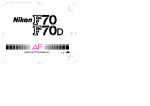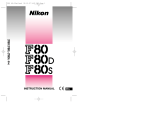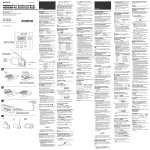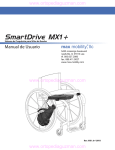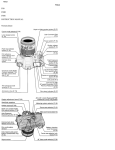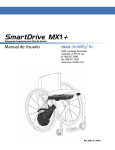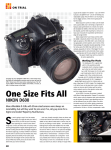Download Oregon Scientific PV 100 Digital Camera User Manual
Transcript
Model: PV 100 User Manual Manuale d'uso Manuel d'utilisation PV100 Eng Cover R7 a OP 1 9/9/04, 2:45 PM EN 3.0 MEGA-PIXEL DIGITAL CAMERA WITH JUMBO DISPLAY USER MANUAL USER MANUAL CONTENTS Introduction ................................................................................. 1 Product Overview ....................................................................... 2 Front View .............................................................................. 2 Back View .............................................................................. 2 Mode Switch ........................................................................... 2 4-Way Direction Controller ..................................................... 3 Getting Started ............................................................................ 3 Package Contents .................................................................. 3 Installing and Charging the Batteries ..................................... 4 Attaching the Strap ................................................................. 4 Memory Storage ..................................................................... 5 Installing the SD Card ............................................................ 5 Removing the SD Card .......................................................... 6 Basic Photography ..................................................................... 6 Preparing the Camera ............................................................ 6 Taking Basic Pictures ............................................................. 7 Displaying or Deleting Last Image Taken ............................... 7 Selecting a Flash Mode .......................................................... 7 Zooming ................................................................................. 8 Using the Self-Timer ............................................................... 9 Basic Functions and Settings .................................................. 10 Camera Modes ..................................................................... 10 Setup Menu ................................................................................ 11 P. Counter (Picture Counter) ................................................ 11 Set Clock .............................................................................. 11 Set City ................................................................................. 12 Show Time ........................................................................... 12 Language ............................................................................. 12 Beep Tone ............................................................................ 12 PV100 Eng contents R7 a OP 1 9/9/04, 2:45 PM EN Auto Off (Auto Power-Off)) ................................................... 13 TV Out .................................................................................. 13 File Number .......................................................................... 13 Macro ................................................................................... 14 Format .................................................................................. 14 Reset .................................................................................... 14 LCD Bright (LCD Brightness) ............................................... 14 System Information .............................................................. 15 Record Mode Menu Options .................................................... 15 Switching Between Camera and Movie Mode ..................... 15 Size ...................................................................................... 15 Quality (Picture Quality) ....................................................... 16 White Balance ...................................................................... 16 Metering ............................................................................... 17 ISO ....................................................................................... 18 EV (Exposure Compensation Setting) ................................. 18 Shooting Movies ....................................................................... 18 Movie Menu .......................................................................... 19 Playback of Images and Movies .............................................. 20 Multi-Frame Review ............................................................. 21 Zooming into Playback Images ............................................ 21 Scrolling a Magnified Image ................................................. 21 Deleting a Playback Image .................................................. 22 Movie Playback .................................................................... 22 Deleting a Playback Movie ................................................... 22 Playback Menu ..................................................................... 22 Deleting Multiple Images or Movies ..................................... 23 Protecting Images or Moviese .............................................. 24 Specifying Digital Print Order Format (DPOF) ..................... 24 Slideshow ............................................................................. 25 Rotating Images ................................................................... 26 Connecting to External Devices .............................................. 26 Connecting to a TV .............................................................. 26 Installing Software Drivers (Windows-Based PC) ................ 27 Transferring Files from Camera to PC or Macintosh ............ 27 Disconnecting the Camera from the PC (Windows ME, 2000 and XP Users Only) ............................ 28 Addendum ................................................................................. 29 PV100 Eng contents R7 a OP 2 9/9/04, 2:45 PM PV100 Eng contents R7 a OP 3 9/9/04, 2:45 PM EN Memory Capacity, Size and Quality ..................................... 29 Troubleshooting ........................................................................ 29 Specifications ............................................................................ 32 Important Notice ....................................................................... 34 Statement of Responsibility .................................................. 34 Notes on Copyright .............................................................. 34 General Warnings ..................................................................... 34 Cleaning the Digital Camera .................................................... 35 About Oregon Scientific ........................................................... 35 Trademark Information ............................................................. 36 FCC Statement .......................................................................... 36 EN INTRODUCTION Thank you for selecting the Oregon Scientific 3.0 Mega-Pixel Digital Camera with Jumbo Display as your personal product of choice. The camera features a large, ease-to-view 3.5-inch (diagonal) LCD and 2x digital zoom. The camera comes with 16MB of internal memory, and is compatible with Secure Digital card to store many of your favourite pictures and movies. Your camera is designed to give you many years of reliable service. Other features Include: • Photo preview on jumbo 3.5-inch TFT display • Auto-focus lens • Self-timer • Movie capture and playback • Video output • USB 1.1 interface • Macro, White Balance and Exposure compensation settings • Spot / Evaluative / Center Light Meter modes • User interface available in 6 languages • Compatible with Windows 98SE / ME / 2000 / XP and MAC OS 9.x / 10.x 1 PV100 Eng R7 a OP 2 9/9/04, 2:45 PM EN PRODUCT OVERVIEW FRONT VIEW 1 4 5 2 6 7 3 8 9 10 1. SHUTTER RELEASE Button 2. Flash 3. ON / OFF Switch 4. Speaker 5. Microphone 6. Self Timer Lamp / Auto Focus Assist Light 7. Lens 8. Video Output 9. USB Connector 10. DC Jack BACK VIEW 5 6 1 7 8 9 10 2 3 11 12 13 4 1. LCD 2. Cradle Connector 3. Camera Stand Connector 4. Battery / SD Card Compartment 5. Left LED (Flash Light Status) 6. Right LED (Auto-Focus Status) 7. Mode Switch 8. (Zoom In) / (Zoom Out) Buttons 4-Way Direction Controller 9. 10. Strap loop 11. DISP / OK Button 12. RESET 13. MENU Button MODE SWITCH 1. Record Mode 2. Playback Mode 1 2 2 PV100 Eng R7 a OP 3 9/9/04, 2:45 PM EN 4-WAY DIRECTION CONTROLLER 1 1. Self-Timer ( ) 2. Flash / Trash ( ) 3. Macro ( ) 3 2 GETTING STARTED PACKAGE CONTENTS When you unpack your digital camera, make sure to keep all the packing materials in a safe place, in case you need to later return it for servicing. In the box, you will find: • • • • • • • AC adaptor Li-Ion rechargeable battery Carrying pouch USB cable Video cable User manual CD-ROM 3 PV100 Eng R7 a OP 4 9/9/04, 2:45 PM Your camera comes with a rechargeable Lithium-Ion (Li-Ion) battery. To prevent damage, correctly insert the battery as shown. T I P : To m a x i m i z e t h e performance of your camera and for greater battery life, control the use of the flash, photo review, and LCD brightness levels. The camera's battery can be charged in a variety of ways: A. Through the camera itself by connecting the AC adaptor through the PV100's DC jack. B. By docking the camera into a PV100D cradle and connecting the AC adaptor through the DC jack. C. By taking out the battery from the camera and inserting into the battery slot of the cradle for charging. NOTE: It takes approximately 6 hours to fully charge the Li-Ion battery. The right LED (Refer to P.2) showing red means the camera is being charged. When the battery is fully charged, the right LED turns off. NOTE: In a non-controlled environment, many factors can affect battery life such as temperature, use of the flash, photo review, LCD display brightness levels and so on. ATTACHING THE STRAP 1. Pass the thin loop of the strap through the camera's strap ring. 2. Pass the other end of the strap through the loop. 3. Tighten by pulling the loop. 4 PV100 Eng R7 a OP 5 9/9/04, 2:45 PM EN INSTALLING AND CHARGING THE BATTERIES EN MEMORY STORAGE The Secure Digital (SD) card is an external memory card that can be plugged into your digital camera for storing images and movies. Below is a list of compatible SD cards that have been tested and verified for use with the PV100: SanDisk: 64MB, 128MB, 256MB Panasonic: 32MB, 64MB, 128MB, 256MB Toshiba: 32MB, 64MB, 128MB, 256MB Operation is not guaranteed for other, unlisted memory cards. For more details on the above cards, please contact the manufacturer directly. The type of memory currently used by the camera is indicated on the LCD: ICON MEMORY TYPE DESCRIPTION Files are stored in the camera's internal memory. SD card has been installed. Files are stored on the card's memory. Internal External NOTE: When the SD card is installed, all images and movies taken are automatically stored on the card. Images and movies stored in the camera's internal memory can be viewed directly from the camera, TV using a video output cable, or transferred to the PC via a USB connection. They cannot be transferred or copied to the SD card. INSTALLING THE SD CARD 1. Turn off the camera. 2. Slide the card into the memory slot until it clicks into position. NOTE: The SD card will not insert fully into the slot if it is facing the wrong way. Be careful not to apply undue force to the card. 5 PV100 Eng R7 a OP 6 9/9/04, 2:45 PM 1. Turn off the camera. 2. Push against the card lodged inside the memory slot. The card automatically ejects itself out of the slot. BASIC PHOTOGRAPHY PREPARING THE CAMERA 1. At the camera’s handgrip position, slide the ON / OFF switch to ON to turn on the camera. 2. Check the battery indicator to make sure there is enough power. ICON DESCRIPTION Adequate power remains Battery is running low Battery is running very low Battery is exhausted 3. Slide the Mode Switch to the desired setting (Record Mode or Playback Mode). The Mode Switch is used to either record or playback images or movies taken. 4. In Record Mode, press the DISP / OK button to toggle between 3 levels of display information settings: A. LCD with photo information displayed. B. LCD without photo information displayed but Date / Time and battery icon is displayed. C. Turn off LCD. 6 PV100 Eng R7 a OP 7 9/9/04, 2:45 PM EN REMOVING THE SD CARD EN TAKING BASIC PICTURES 1. Make sure the camera is set to Record Mode (that is, in Camera Capture Mode). 2. Frame and view your subject on the LCD. 3. Press the SHUTTER RELEASE button. The image taken is displayed on the LCD for approximately a second (Auto Review). 4. Once the Auto Review has finished, you may proceed to take the next picture. NOTE: The camera’s auto-focus assist light automatically turns on in dark environments where more lighting is needed for picture taking. The right green LED will light up and blink slowly during auto-focus, and stop blinking once auto-focus is ready. The right green LED will blink quickly to indicate auto-focus is not ready. NOTE: When memory is full, no more images can be stored. The camera will beep and the words "Internal Memory Full" or "Memory Card Full" will appear on the LCD. DISPLAYING OR DELETING LAST IMAGE TAKEN 1. Set the camera to Playback Mode. 2. Use and press or to view the last image taken. 3. You may choose to delete the image by pressing and DISP / OK to confirm deletion. The Trash icon is shown on the LCD. 4. Press DISP / OK again to return to shooting. SELECTING A FLASH MODE While in Record Mode, use and press to turn on the camera flash and observe the flash icon on the LCD. When a picture with flash has been taken, the left red LED will blink while the flash is recharging. Once the LED stops blinking, you can resume taking pictures again. When no flash light is set, the left LED will turn green. NOTE: When the flash is recharging, the LCD will turn off temporarily. 7 PV100 Eng R7 a OP 8 9/9/04, 2:45 PM NOTE FUNCTION Auto Flash On Flash Off DESCRIPTION The flash may go off automatically, depending on light conditions. The flash goes off regardless of lighting condition. The flash will not go off (default setting) ZOOMING Your digital camera comes with a 2x digital zooming function (this is described as x2 in the camera). By default, the zooming is not enabled. 1. In Record or Playback Mode, increase zooming by pressing . The Digital Zoom icon on the LCD, , indicates the current zoom level. 2. To decrease the zooming, press . Camera Mode Zooming Options: Default Zoom Larger x1.0 / x1.1 / x1.2 / x1.3 / x1.4 / x1.5 / x1.6 / x1.7 / x1.8 / x1.9 / x2.0 Movie Mode Zooming Options: Default Zoom Larger x1.0 / x1.2 / x1.4 / x1.6 / x1.8 / x2.0 8 PV100 Eng R7 a OP 9 9/9/04, 2:45 PM EN NOTE: When taking pictures with flash on, the camera’s battery life will be shorter so you will need to keep an eye on the battery status. EN NOTE: In Movie Mode, once the SHUTTER RELEASE button is pressed and recording starts, zooming cannot be further adjusted for the duration of the recording. USING THE SELF-TIMER The Self-Timer function counts down 10 seconds before the camera automatically takes a picture by itself. This is useful when you want to be in the picture and there is no one else to press the SHUTTER RELEASE button. 1. Slide the Mode Switch to Record Mode. 2. Use and press to activate the Self-Timer function. The SelfTimer lamp at the front of the camera beside Lens lights up and the Self-Timer icon appears on the LCD. TIP: If you wish to cancel the Self-Timer function at this stage, press again and the icon on the LCD will disappear. 3. Press the SHUTTER RELEASE button. Audible beeps can be heard and the Self-Timer lamp will start blinking. The number displayed next to the LCD’s Self-Timer icon will appear and start counting down from 10 seconds to 0 seconds. 4. Press the SHUTTER RELEASE button again anytime during count down between 10 seconds to 4 seconds and the SelfTimer will jump to count down from 3 seconds to 0 seconds. TIP: Press the SHUTTER RELEASE button at this stage during count down from 3 seconds to 1 second to cancel the Self-Timer function. NOTE: The Self-timer is set to start count down from 10 seconds only. NOTE: Once a picture has been taken, the Self-Timer will automatically disable. 9 PV100 Eng R7 a OP 10 9/9/04, 2:45 PM EN BASIC FUNCTIONS AND SETTINGS CAMERA MODES MODE FUNCTION SECONDARY DESCRIPTION MENU Record Setup Can be set as: • Camera Mode (digital still images with adjustable settings) • Movie Mode (allows you to shoot movies) Playback Setup Play back and review all images recorded onto the camera’s internal or external memory card. Record Mode Playback Mode 1. Press MENU to access the menu screens, where setting options can be specified. To switch between Primary and Secondary Menus, highlight the top menu fields. 2. Use and press or to switch between Record or Playback modes and the Setup menu). 3. Use and press or to navigate through the Record or Playback Mode and setup options. 4. Use and press or to select setup options. 5. Press DISP / OK to confirm any setting changes. 10 PV100 Eng R7 a OP 11 9/9/04, 2:45 PM EN Example of a menu screen: Primary Menu Field (currently accessed) Secondary Menu Field (not currently accessed) Highlighted Setting Option Currently Chosen Total No. of Menu Pages MENU Current Menu Page OK Descriptions of Button Functions Button On Camera SETUP MENU Under the Setup Menu, which is available in all modes, the basic settings of the camera can be adjusted. P. COUNTER (PICTURE COUNTER) The Picture Counter can count the number of images already taken (count up) or available to be saved onto memory (count down). SET CLOCK This sets the Date and Home Time of the camera. When accessed, a new Set Clock configuration screen will appear. Use and press or to adjust the values of each field below. MENU OK A. Current Date Field – adjust the current date of the camera. B. Date Format – choose from the following date formats: • D/M/Y (date, month, year) 11 PV100 Eng R7 a OP 12 9/9/04, 2:45 PM SET CITY You can choose to display the current time in two different time zones. Configure the time zone of your Home and World City from a list of city names. MENU OK NOTE The World Time cannot be directly set. It automatically adjusts itself via the time zone offset, using the Home Time values specified in the Set Clock setting. If your city is not selectable, choose another city within your time zone instead. SHOW TIME You can choose to display either the Home Time (default setting) or World Time on your camera. NOTE: icon is shown on the LCD if World Time is selected. However, no icon is displayed if Home Time is selected. LANGUAGE Choose your menu language: English (default setting), French, German, Spanish, Italian, and Portuguese. BEEP TONE The camera will make "beeping" sounds during certain functions. This "beeping" sound can be turned on (default setting) or off in the Setup Menu options. 12 PV100 Eng R7 a OP 13 9/9/04, 2:45 PM EN • M/D/Y (month, date, year) • Y/M/D (year, month, date) C. Current Time Field – adjust the current time of the camera. D. Time Format – choose between 12-hr (AM/PM) or 24-hr display. EN AUTO OFF (AUTO POWER-OFF) You can set the camera to turn off automatically when no operation is performed. The period of time before shut-down can be adjusted (None, 1 min., 3 min., or 5 min.) The default auto off time setting is 3 min. NOTE: Auto Off is not available in slideshow mode or when the camera is connected to a PC. TV OUT If connecting the camera to a TV, you can set the camera’s TV output system to either the PAL or NTSC standards. The default TV Out setting is set to PAL. FILE NUMBER Your camera keeps an internal file counter for every image and movie taken that can be reset. The setting options are Continue and New (default setting). NOTE: All files are stored within a designated folder. The initial folder is always numbered at 100. A. Under the Continue default option, the internal file counter is first set to “0001”. Every subsequent picture is assigned an incremental File Number. NOTE: The internal file counter increments by 1 regardless of the media unless it is reset. B. Under the New option, the internal file counter to “0001” for new media only. But in case there are image files already present inside the storage media, it will start counting from the highest file number of the media. NOTE: The File Number setting should be set to New only if either the internal memory or SD card has been newly formatted, or a completely new SD card has been installed. 13 PV100 Eng R7 a OP 14 9/9/04, 2:45 PM FORMAT This option will format all data in either the internal memory or the external SD card / MMC, including all protected files. CAUTION: Do not eject the SD card / MMC while the card is being formatted, as this may damage the card. Formatting deletes all data from the memory device chosen. Files will not be recoverable. RESET You can reset all camera settings to factory default. Refer to the Setup Menu table to see the defaults for each setting. NOTE: The reset function can reset all the settings to factory default except for the current time and date. LCD BRIGHT (LCD BRIGHTNESS) You can adjust the LCD brightness level to compensate for different lighting conditions. For example: • If there is plenty of ambient light such as in bright sunshine, you can adjust the brightness levels higher to make the display easier to see. 14 PV100 Eng R7 a OP 15 9/9/04, 2:45 PM EN MACRO The PV100’s macro-focusing function lets you move the camera lens very close to the subject, allowing you to take close-up images with clarity and in detail. EN • If ambient light levels are relatively low such as indoors or at night, you can adjust the brightness levels lower to make the display easier to see. TIP: To maximize battery life, keep brightness settings low. SYSTEM INFORMATION This option allows you to check the camera model number and current version of firmware installed. RECORD MODE MENU OPTIONS SWITCHING BETWEEN CAMERA AND MOVIE MODE MENU Use the menu to switch between Camera and Movie modes. In Movie Mode, you can record movies at 10 frames per second. The duration of the movie will depend on the battery life and memory available. OK NOTE In Movie Mode, you can only adjust the white balance, EV and ISO. In Camera Mode (default setting), all settings will apply. SIZE Image size represents picture resolution. The resolution is directly related to the number of pixels of the camera. As such, 3.0 Mega-pixel can be arranged as 2048 x 1536 pixels or lower. NOTE: The higher the resolution size of an image, the larger the memory space it occupies. ICON TYPE OF MEDIA DESCRIPTION Super Fine Image (Default setting) Excellent detail and resolution (2048 x 1536, 3.0 Mega-Pixel). 15 PV100 Eng R7 a OP 16 9/9/04, 2:45 PM DESCRIPTION TYPE OF MEDIA EN ICON Fine Image Very good detail and resolution (1600 x 1200, 2.0 Mega-Pixel). Normal Image Good clarity and resolution (1280 x 1024, 1.3 Mega-Pixel). Basic Image Basic quality and resolution (640 x 480, VGA). QUALITY (PICTURE QUALITY) The picture quality represents the compression rate of the images taken. NAME OPTION HQ High Quality STD Standard ECO Economy DESCRIPTION Good image quality, high amount of image data Standard quality, medium amount of image data Lowest quality, taking up the least memory space NOTE: The higher image quality and resolution, the larger the memory space it occupies on the memory card. WHITE BALANCE You can take pictures according to light conditions by setting the camera's white balance function. By using this, the images will have the correct balance of colour. MENU OK 16 PV100 Eng R7 a OP 17 9/9/04, 2:45 PM EN ICONS SETTINGS OPTIONS Auto (default setting) Adjusts the white balance automatically Sunlight Use outside in sunlight Shade Use outside in the shade Yellow F.L. Use under yellow fluorescent lamp White F.L. Use under white fluorescent lamp Tungsten Use under electric or other tungsten light METERING Metering determines your subject's correct exposure. The camera will compute the brightness levels, contrast, and amount of bright to dark parts in the scene automatically. MENU ICONS OK SETTINGS OPTIONS Matrix (multisegment) Evaluated by splitting the scene into multiple zones, then calculate each zone's exposure via the camera's computations. Ideal for general picture-taking. Central (Centreweighted) Averages the exposure of the entire scene but gives extra weight to the centre. Use for backlit subjects (default setting). Spot Only the small area at the centre of the screen determines the exposure. Ideal for highlighting the main subject. 17 PV100 Eng R7 a OP 18 9/9/04, 2:45 PM The ISO setting affects the camera's sensitivity to light. MENU SPEED NOTE: An image taken at higher ISO speeds may contain more "noise" or graininess than an image taken at lower speeds. OK DESCRIPTION The camera sets the speed automatically (default setting) ISO rating 50. Use for very brightly lit scenes ISO rating 100. Use for brightly lit scenes ISO rating 200. Use for normally lit scenes EV (EXPOSURE COMPENSATION SETTING) Exposure compensation is required when there is an extreme difference in brightness between the background and the subject. Use this setting to manually brighten or darken an image. Default setting is 0.0. EV +2.0 / + 1.7 / +1.3 / +1.0 / +0.7 / +0.3 / 0.0 / -0.3 / -0.7 /-1.0 / -1.3 / -1.7 / -2.0 SHOOTING MOVIES The Movie Mode enables you to take movies. The length of the movie that can be taken depends on the amount of memory available within your camera's current memory storage. 18 PV100 Eng R7 a OP 19 9/9/04, 2:45 PM EN ISO EN Movie Mode On-Screen Display Total Available Time for Recording Movie Mode (→P.20) ISO (→P.18) White Balance (→P.17) Memory Type (→P.5) Zoom Level (→P.8) EV (→P.18) Current Elapsed Recording Time (hh:mm:ss) Battery Level Indicator (→P.6) Current Date (→P.11) Current Time (→P.11) FUNCTION DESCRIPTION Toggling LCD Information Zooming Identical procedures to Camera Modes Identical procedures to Camera Modes Begin Recording Movie Stop Recording Movie Press the SHUTTER RELEASE button Press the SHUTTER RELEASE button again after recording has started MOVIE MENU 1. Press MENU to access the Movie Menu. 2. Use to navigate the menu screen. Press DISP / OK to confirm setting changes. SETTINGS OPTIONS White Balance Auto (default) / Sun light / Shade / Yellow F.L. (Fluorescent Lamp) / White F.L. (Fluorescent Lamp) / Tungsten Auto (default) / 50 / 100 / 200 ISO EV +2.0 / + 1.7 / +1.3 / +1.0 / +0.7 / +0.3 / 0.0 (default) / -0.3 / -0.7 / -1.0 / -1.3 / -1.7 / -2.0 19 PV100 Eng R7 a OP 20 9/9/04, 2:45 PM OPTIONS Off / On (default) EN SETTINGS Mic NOTE: You can enable or disable audio recording while shooting a movie. The microphone icon is displayed on the LCD. PLAYBACK OF IMAGES AND MOVIES In Playback Mode, you can review the images and movies stored within your current active storage memory. The last image or movie taken is displayed on the LCD in Playback Mode. Use and press or to view through the images and movies taken. NOTE: If the SD card / MMC is inserted, Playback Mode will only show images and movies stored on the card. To access data stored within the internal memory, the SD / MMC card must first be removed. IMAGE PLAYBACK Image Playback Mode On-Screen Display Size (→p.15) File No. (→p.13) Memory Type (→p.5) Protect Mode Indicator (→p.24) Folder number Current Date (→p.11) Battery Level Indicator (→p.6) Current Time (→p.11) MOVIE PLAYBACK Movie Playback Mode On-Screen Display Total Recorded Time Folder Number Movie Mode (→p.20) Memory Type (→p.5) File No. (→p.13) Protect Mode (→p.24) Current Date (→p.11) Battery Level Indicator (→p.6) Current Time (→p.11) 20 PV100 Eng R7 a OP 21 9/9/04, 2:45 PM EN Your PV100 digital camera has the ability to capture and playback movies with audio because of its built-in microphone and speaker. Note however, that playback volume is fixed and cannot be adjusted. MULTI-FRAME REVIEW The Multi-Frame Review shows, as thumbnails, up to nine recorded images and movies on the LCD. For movies, the first frame is displayed. Protected Image Current Selected File Movie File Button On Camera Description Of Button Function ZOOMING INTO PLAYBACK IMAGES The zooming function can magnify images up to 5x (this is indicated as x5.0 on the camera) on the LCD: x1.0 / x1.5 / x2.0 / x2.5 / x3.0 / x3.5 / x4.0 / x4.5 / x5.0. 1. Wait until the icons disappear from the playback image. 2. Press to zoom in any image. The icon appears, as well as the current magnification level. 3. To zoom out of the image, press . 4. Press DISP / OK to exit zooming mode. SCROLLING A MAGNIFIED IMAGE While an image is magnified, only a portion of the image will be visible. Press the SHUTTER RELEASE button to enable / disable scrolling, then use to scroll to other parts of the image. NOTE: All zooming functions are disabled while the Scrolling Mode is enabled. 21 PV100 Eng R7 a OP 22 9/9/04, 2:45 PM MOVIE PLAYBACK To playback movies: 1. Wait until the icons disappear from the playback movie. 2. The icon will then appear. 3. Press the SHUTTER RELEASE button to start playback. 4. Press DISP / OK to hide the Progress Bar. 5. Press again to restore the Progress Bar. 6. Press the SHUTTER RELEASE button again to stop playback. The movie will return to Movie Playback LCD screen. NOTE: All zooming functions are disabled during Movie Playback mode. DELETING A PLAYBACK MOVIE To delete the movie currently being viewed, stop the playback, press and confirm. Protected movies (indicated with ) cannot be deleted and must be unprotected first. 1. In playback mode, press DISP / OK. Thumbnails of images will appear on the LCD. 2. Use to navigate. Press DISP / OK to view a chosen image or movie fully. PLAYBACK MENU 1. Press the MENU button to access the Playback Menu. 2. Use to navigate the menu screen. Press DISP / OK to confirm setting changes. 22 PV100 Eng R7 a OP 23 9/9/04, 2:45 PM EN DELETING A PLAYBACK IMAGE To delete the image currently being viewed during playback, press and confirm. Protected images (indicated with ) cannot be deleted and must be unprotected first. EN FUNCTIONS OPTIONS Delete Protect Cancel / Select Images / All Images Select Images / All Images DPOF (Digital Print Order Format) Slide Rotate Select Images / All Images Start / Interval / Repeat Cancel / 90° / 270° DELETING MULTIPLE IMAGES OR MOVIES The Delete options within the Playback Menu can delete multiple or all images and movies. NOTE: Protected images and movies (indicated with ) cannot be deleted and must be unprotected first. DELETING SELECTED IMAGES OR MOVIES 1. When "Select Images" is selected, the OSD displays up to nine thumbnail images similar to the Multi-Frame Review setting. Use to navigate. 2. Highlight an image, then press DISP / OK to confirm your selection. 3. The icon will then appear to indicate that the image is set for deletion. To cancel the deletion, press DISP / OK again. 4. Repeat Step 2 to set multiple images or movies for deletion. 5. Follow the rest of the LCD on-screen options to confirm deletion. DELETING ALL IMAGES OR MOVIES When "All Images" is selected, follow the rest of the options to confirm the deletion of all images and movies. 23 PV100 Eng R7 a OP 24 9/9/04, 2:45 PM You can protect / unprotect selected or all images and movies from accidental deletion. MENU OK SELECTED IMAGES OR MOVIES 1. When "Select Images" is selected, the LCD displays up to nine thumbnail images similar to the Multi-Frame Review setting. Use to navigate. 2. Highlight an image, then press DISP / OK to confirm your selection. The icon will then appear to indicate that the image is set for protection. 3. To cancel the protection, press DISP / OK. 4. Repeat Step 2 to set multiple images or movies for protection. 5. Follow the rest of the LCD on-screen options to confirm protection. ALL IMAGES OR MOVIES 1. When "All Images" is selected, select the "Set Protect All" to "On" to confirm the protection of all images and movies. 2. To unprotect all images and movies, select the "Set Protect All" to "Off". SPECIFYING DIGITAL PRINT ORDER FORMAT (DPOF) MENU The DPOF option in the Playback Menu is used to specify the quantity of selected or all images for printing from the SD card. When used, the SD card can then be used in printers or taken to specialists in order to print the images. OK NOTE: This function is only used for still images. Movies cannot be transferred to digital prints. 24 PV100 Eng R7 a OP 25 9/9/04, 2:45 PM EN PROTECTING IMAGES OR MOVIES EN NOTE: You can only specify the DPOF of the internal memory by transferring the images to a blank SD card via an SD card reader (sold separately). While you can take your SD card to a specialist for printing images, you must take the camera to a specialist to print any images stored in internal memory. SPECIFYING DPOF OF SELECTED IMAGES 1. When "Select Images" is selected, the OSD displays up to nine thumbnail images similar to the Multi-Frame Review setting. Use to navigate. 2. Highlight an image, then press DISP / OK to confirm your selection. 3. Use to press or to set the number of prints for the se lected image (up to a maximum of 9 for the selected image). When done, press DISP / OK once again. 4. Repeat Step 2 to select more images for printing or change the previously specified numbers. 5. Press DISP / OK and follow the rest of the LCD on-screen op tions to confirm the DPOF setting. SPECIFYING DPOF OF ALL IMAGES 1. When "All Images" is selected, all images will be set to the same specified printing number. 2. Use to press or to set the number of prints of all stored images. 3. Follow the rest of the options to confirm the DPOF setting. SLIDESHOW You can play back all images and movies in a slideshow format. The interval between images can be specified. During the slideshow, press MENU to stop. From here, you may choose to continue or exit the current slideshow. SETTINGS DESCRIPTIONS Start Slideshow according to the specified Interval and Repeat options. Start 25 PV100 Eng R7 a OP 26 9/9/04, 2:45 PM DESCRIPTIONS Specifies the amount of time the camera will display an image before moving on to the next image. The options are 3 sec., 5 sec., and 10 sec. When set to On, the slideshow immediately replays when the final image is displayed. Repeat ROTATING IMAGES In Playback Mode, you can rotate images to view them from different angles. Images can be rotated 90° or 270°. Movies cannot be rotated. MENU OK CONNECTING TO EXTERNAL DEVICES CONNECTING TO A TV You can playback the images and movies you have recorded on the camera on your TV. Connect your camera to the TV via the included video cable. NOTE: Be sure to adjust the TV Out setting to correspond with your country's system (PAL / NTSC) before connecting the camera to the TV. 1. Turn off the TV and camera before connecting the video cable. 2. Plug the video cable into the camera's video socket. 3. Connect the video cable's yellow connector to the yellow AV input terminal of your TV. 4. Turn the TV and camera on. Make sure to switch the TV to the appropriate AV channel display. NOTE: LCD is automatically turned off when the camera is connected to a TV. 26 PV100 Eng R7 a OP 27 9/9/04, 2:45 PM EN SETTINGS Interval EN NOTE: All image / movies can be viewed in Playback Mode or the camera can be used as a TV Cam in Record Mode. INSTALLING SOFTWARE DRIVERS (WINDOWS-BASED PC) Use the USB cable included to connect the camera to your Windowsbased PC. This enables you to transfer, edit, and playback pictures and movies onto your PC. Users of Windows 98SE-based PCs must install the software first before connecting the camera to the computer. 1. Insert the CD labelled "PV100" into your CD-ROM drive. The installation will start automatically. 2. If the "autorun" feature is disabled on your PC, start the installation by running [x:\setup.exe] where "x:" is the drive letter of the CD-ROM drive. 3. Follow the on-screen instruction to complete the installation of the camera drivers and software. When done, click on the [Finish] button on-screen to restart the PC. NOTE: The Macintosh does not require software driver installation. TRANSFERRING FILES FROM CAMERA TO PC OR MACINTOSH NOTE: Only the images and movies stored in the camera's current memory device (SD card or internal memory) will be visible on the PC or Macintosh. NOTE: The LCD is automatically off when the camera is connected to the PC or Macintosh. 1. Turn on your PC or Macintosh and allow your system's operating system to boot up. 2. Turn off your digital camera. Connect the camera and your PC or Macintosh via the USB cable. 3. Turn on your digital camera to any mode. The device's status lamp will blink. 27 PV100 Eng R7 a OP 28 9/9/04, 2:45 PM DISCONNECTING THE CAMERA FROM THE PC (WINDOWS ME, 2000 AND XP USERS ONLY) For PC users with Windows ME, 2000, or XP operating systems, the camera device driver should be stopped before disconnecting the USB cable. 1. Find the "Unplug or Eject Hardware" icon in your Windows system tray. 2. Right-click on the icon. The "Stop USB Disk" option will pop up. Highlight and left-click on the option. 3. A pop-up window will inform you that the USB Device can now be safely removed. 4. Disconnect the USB cable from the camera and / or from the PC. NOTE: For Macintosh systems, drag and drop the "Untitled" icon from desktop to the "Trash" icon before disconnecting. NOTE: Before unplugging your camera from your computer, wait at least 15 seconds after the transfer is completed to prevent any data loss that may occur. 28 PV100 Eng R7 a OP 29 9/9/04, 2:45 PM EN 4. On a PC, the camera will appear as a Removable Disk drive on My Computer. On the Mac, it will appear as a drive icon on the desktop (i.e., Untitled). 5. Double-click on the Removable Disk drive. Two folders, [DCIM] and [MISC], are now visible. Ignore the [MISC] file (it contains DPOF information) and double-click on the [DCIM] folder. 6. A new subfolder is now visible, [100DSHOT]. It contains all images stored as .JPG files and movie clips as .AVI files. 7. You can double-click on the images and movies to view them. These files can also be deleted, copied, or moved like normal computer files. EN ADDENDUM MEMORY CAPACITY, SIZE AND QUALITY The table below indicates the number of images that can be stored when using the camera's 16MB internal memory. RESOLUTION APPROXIMATE NUMBER OF PICTURES STORED UNDER THE FOLLOWING PICTURE QUALITY SELECTIONS HIGH STANDARD ECONOMY Super Fine (2048 x 1536) 9 12 Fine (1600 x 1200) 17 22 16 28 Normal (1280 x 1024) 25 32 40 Basic (640 x 480) 123 172 291 NOTE: The above table is based on standard shooting conditions tested by Oregon Scientific and may vary depending on the subject, shooting conditions, capture modes, and SD card memory capacity. TROUBLESHOOTING PROBLEM No Power SYMPTOM Power will not turn on CHECK THIS Batteries are exhausted Batteries are inserted incorrectly REMEDY Replace with new batteries Insert the batteries correctly 29 PV100 Eng R7 a OP 30 9/9/04, 2:45 PM Taking Pictures SYMPTOM Power turns off after turning on Cannot take pictures when the SHUTTER RELEASE button is pressed Flash does not go off as expected CHECK THIS Battery level is too low REMEDY Replace with new batteries Auto Off Function is enabled Disable the Auto Off Function Camera not turned on No space on the SD card / internal memory Turn on the camera Delete unwanted files or insert a new SD card Mode Switch is set to Playback mode Change the Mode Switch to Camera or Movie Mode Flash is set to No Flash Mode Enable flash by changing it to another setting Mode Switch is Change the set to Playback Mode Switch to or Movie Mode Camera Mode Image taken appears too dark or blurred Flash has not finished charging Wait until the Status Lamp stops blinking Check your Flash Mode Turn on the flash by changing the Flash Mode Move closer to the subject The subject is too far away 30 PV100 Eng R7 a OP 31 9/9/04, 2:45 PM EN PROBLEM EN PROBLEM Playback Connecting with External Devices SYMPTOM Cannot play back images or movies CHECK THIS The lens is dirty Incorrect focus mode setting Mode Switch is not set to Playback Mode No images or movies are recorded REMEDY Clean the lens with a soft cloth Set the dial to the correct focus distance Set Mode Switch to Playback Mode Images located in internal memory instead. Remove SD card Cannot delete images or movies Images or movies are protected Unprotect the images or movies Picture not shown on TV when connected Check cable connection Make sure yellow video cable is plugged into the TV's AV terminal TV channel should be switched to the appropriate AV channel Make sure both ends of the USB cable are connected Check channel on TV Camera does not appear as Removable Disk when connected to a PC Check the USB cable connection 31 PV100 Eng R7 a OP 32 9/9/04, 2:45 PM SYMPTOM CHECK THIS REMEDY Camera or PC Turn on the is not turned on camera and PC SPECIFICATIONS TYPE DESCRIPTION 3.5" high-density CMOS Total number of pixels: 3.0 million Sensor Image size Selectable from: • 2048 x 1536 pixels • 1600 x 1200 pixels • 1280 x 1024 pixels • 640 x 480 pixels (VGA) File Format DCF- and DPOF-compliant (Exif ver. 2.2 JPEG-compliant) Type: auto-focus Focus range: 1m to infinity (normal) 20-30cm (macro) F-number: 2.8, 8.0 Focal length: 8.4mm (35mm equivalent) Lens Digital zoom 2x Shooting distance Macro: 20-30cm Normal: 1m to infinity Approx. 1m~3m Flashlight Distance Operation Environment Display Temperature: Approx. 0°C~40°C 3.5" TFT LCD 32 PV100 Eng R7 a OP 33 9/9/04, 2:45 PM EN PROBLEM EN TYPE Internal Memory Digital Video Recording TV Video Output DESCRIPTION 16MB 320 x 240 pixels, .AVI format Storage Media Secure Digital memory card Digital Output Software Product Dimension USB 1.1 interface to PC ArcSoft PhotoImpression 3.0 109 x 70 x 27 (33 at lens location) mm (L x W x T) Unit Weight Approx. 210g (without battery) Battery Specification Removable Lithium-Ion rechargeable battery (1700mAH) White Balance Auto Exposure Metering Auto 1. Matrix (25 zones) 2. Center weighted (central 9 zones) 3. Spot (central 1 zones) ISO Sensitivity 50, 100, 200 Language user interface PC Compatibility English, French, Spanish, Germany, Italian and Portuguese. Windows 98SE / ME / 2000 / XP; Mac OS 9.x / 10.1 / 10.2 NTSC / PAL compatible 33 PV100 Eng R7 a OP 34 9/9/04, 2:45 PM EN IMPORTANT NOTICE STATEMENT OF RESPONSIBILITY Oregon Scientific assumes no responsibility for any incidental losses (such as the costs of photography or the loss of income from photography) incurred as a result of faults with this product. NOTES ON COPYRIGHT Images recorded using your digital camera cannot be used in ways that infringe copyright laws without the consent of the owner, unless intended only for personal use. Note that some restrictions apply to the photographing of stage performances, entertainments and exhibits, even when intended purely for personal use. Users are also asked to note that the transfer of memory containing images or data protected under copyright laws is only permissible within the restrictions imposed. GENERAL WARNINGS • Do not immerse the device in water or subject the camera to impact or shock. • Do not, under any circumstances, touch the exposed electronic circuitry of the device, as there is a danger of electric shock. • Take special care when handling a damaged LCD display, as the liquid crystals can be harmful to your health. • Do not use or store the device in locations that may adversely affect the product such as rain, snow, desert, and magnetic fields. • Check all major functions when the device is unused for a long period of time. This is to ensure its full operation. Maintain regular testing and cleaning of your device. • Do not look through the viewfinder at the sun or other strong lights. This could damage your eyesight. • Avoid leaving the camera exposed to direct sunlight, as the action of the lens could cause fires. • Remove the batteries and memory card before storing the camera for long periods of time. Then, keep it in a wellventilated place in order to prevent molding. 34 PV100 Eng R7 a OP 35 9/9/04, 2:45 PM EN CLEANING THE DIGITAL CAMERA Use a damp cloth to clean your camera body; dry immediately. To clean your camera lens / viewfinder: 1. Use a blower or a lens brush to remove dirt or dust. 2. Wipe carefully with a soft cloth to remove fingerprints and other stains. Do not touch with fingers. NOTE: Do not use benzene, thinner, or similar cleaning agents to clean your camera, as these may cause permanent damage not covered by the warranty. NOTE: Do not scratch hard objects against the lens or LCD as these surfaces are easily damaged. ABOUT OREGON SCIENTIFIC Visit our website (www.oregonscientific.com) to learn more about Oregon Scientific products such as digital cameras; MP3 players; children's electronic learning products and games; projection clocks; health and fitness gear; weather stations; and digital and conference phones. The website also includes contact information for our customer care department in case you need to reach us, as well as frequently asked questions and customer downloads. We hope you will find all the information you need on our website, however if you'd like to contact the Oregon Scientific Customer Care department directly, please visit www2.oregonscientific.com/service/ support or call 949-608-2848 in the US. For international enquiries, please visit www2.oregonscientific.com/about/international/default.asp 35 PV100 Eng R7 a OP 36 9/9/04, 2:45 PM EN TRADEMARK INFORMATION Windows is a trademark of Microsoft Corporation of the United States and other countries. Windows is an abbreviated term referring to the Microsoft Windows Operating System. MacintoshTM is registered trademark of Apple Computer, Inc. ArcSoft TM and ArcSoft PhotoImpression TM logos are registered trademarks of ArcSoft Inc. All other trademarks mentioned in this manual or other documentations provided with your Oregon ScientificTM product are trademarks or registered trademarks of their respective holders. FCC STATEMENT This device complies with Part 15 of the FCC Rules. Operation is subject to the following two conditions:(1) This device may not cause harmful interference, and (2) This device must accept any interference received, including interference that may cause undesired operation. This equipment has been tested and found to comply with the limits for a Class B digital device, pursuant to Part 15 of the FCC Rules. These limits are designed to provide reasonable protection against harmful interference in a residential installation. This equipment generates, uses and can radiate radio frequency energy and, if not installed and used in accordance with the instructions, may cause harmful interference to radio communications. 36 PV100 Eng R7 a OP 37 9/9/04, 2:45 PM EN However, there is no guarantee that interference will not occur in a particular installation. If this equipment does cause harmful interference to radio or television reception, which can be determined by turning the equipment off and on, the user is encouraged to try to correct the interference by one or more of the following measures: • Reorient or relocate the receiving antenna. • Increase the separation between the equipment and receiver. • Connect the equipment into an outlet on a circuit different from that to which the receiver is connected. • Consult the dealer or an experienced radio/TV technician for help. CAUTION: Modification - The FCC requires the user to be notified that any changes or modifications made to this device that are not expressly approved by Oregon Scientific, Inc. may void the user 's authority to operate the equipment. Interface cable - Use the shielded cable sold or provided by Oregon Scientific, Inc. for your equipment. Using other interface cable may exceed the limits of Class B Part 15 of the FCC rules. Legal Company Name: Oregon Scientific, Inc. Address: 19861 SW 95th Place, Tualatin, Oregon 97062, USA Phone, Fax: (1) 800-853-8883, (1) 503-684-8883 Oregon Scientific PV 100 Tested To Comply With FCC Standards FOR HOME OR OFFICE USE 37 PV100 Eng R7 a OP 38 9/9/04, 2:45 PM © 2004 Oregon Scientific. All rights reserved. 086-003527-021 PV100 Eng Back R7 a OP 1 9/9/2004, 2:45 PM












































